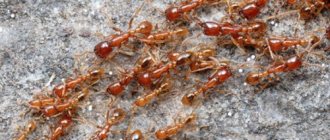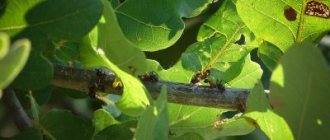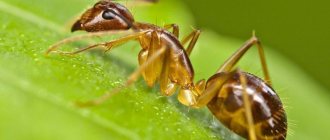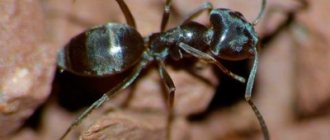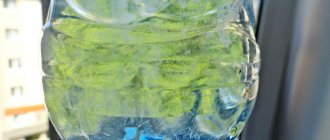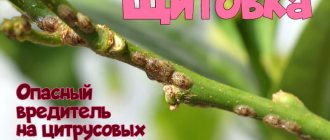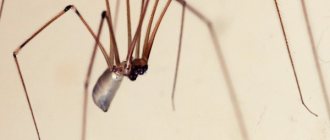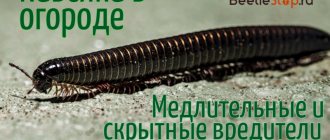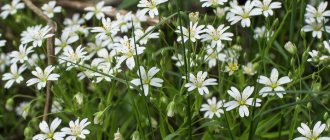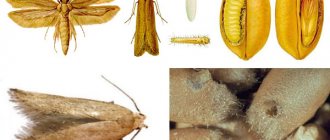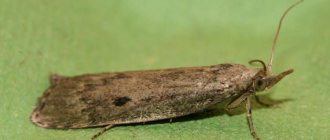The cherry orchard attracts ants with its sweet juice. However, to obtain it, inventive insects use the “services” of aphids. This is an inextricable alliance operating on mutually beneficial terms. Ants carry aphids to the most succulent trees, in return they receive a sweet substance secreted by the aphids after sucking out plant sap. Before looking for the answer to the question of how to get rid of ants on cherries, you need to think about killing aphids.
Ants on cherries: is it good or bad?
Gardeners have an ambivalent attitude towards ants on cherries and other trees. In fact, these are wasps that lost their wings during the Cretaceous period. They have retained the wasp diet: protein for larvae, carbohydrates for adults.
To feed the larvae, the workers carry all the protein they can find:
- caterpillars;
- Zhukov;
- various larvae;
- pieces of meat from dead animals.
By destroying other garden pests, ants bring tangible benefits. But adults also want to eat. They can feed on seeds, plant sap and nectar, but their main source of carbohydrates is honeydew. This is the name given to the excrement of aphids, scale insects and scale insects due to their high sugar content. Gathering is an unreliable business; cattle breeding is more profitable. And the ants found a way out: breeding aphids on trees and bushes.
As a result of evolution, some species even developed a caste of “cattle breeders”. The ant “cattle” spend the winter in warm underground barns. In winter, the owners also take care of the “calves” eggs, licking and cleaning them.
Since any livestock must be grazed, ants carefully bring their “ladies” to the pasture in the spring. The role of the latter is often played by fruit trees in the garden. Aphids graze in their pastures, giving the ants sweet “dew” as payment.
Comment! Ants even protect their “livestock” from “wolves” in the form of predatory ladybugs.
Due to the developed “cattle breeding”, gardeners have classified ants as pests. If the “livestock breeders” are not disturbed, their “cows” can kill young trees, and old ones will certainly lose their harvest. However, without ants, aphids will also appear on trees, since they also fly. This means that you should not fanatically destroy anthills and destroy their inhabitants. It is enough to block their path to the trees.
The appearance of ants on a cherry tree does not mean a disaster, unless they are leaf cutters
Distribution methods
Worms in cherries
One of the ways the pest spreads is through ants. The sweet juice secreted by aphids (honeydew) serves as a constant source of nutrition for the ants. Therefore, they take care of aphid colonies, moving them to new pastures, protecting them from other insects, hoverflies and ladybugs. In mid-summer, sexually mature aphids with wings are born, capable of reproducing and moving over large spaces, up to several tens of kilometers. Females mate with males, laying many black eggs for the winter. In spring the cycle begins again.
Why do ants appear on cherries?
Strictly speaking, they appear on all trees. From the moment the ants wake up, they need to start storing food, and, therefore, including transferring aphids to trees to receive honeydew. Naturally, they transfer their charges to the trees that have already begun to wake up. In early spring there is no suitable grass yet. And not all the trees have even opened their buds yet. At this time, stone fruit crops are actively blooming. It is on them that the ants carry aphids. And then they just run back and forth, collecting their prey and carrying it to the anthill. Since cherry is one of the early waking trees, the appearance of ants on it is natural.
Life cycle of a pest
An ant is an insect with complete metamorphosis. This means that in its development it goes through 4 stages:
- egg;
- larva;
- chrysalis;
- adult.
The ant grows only in the larval stage.
The life cycle begins with an egg. The sex of the future ant depends on whether it is fertilized or not. Fertilized eggs hatch into females, and unfertilized eggs hatch into males. Eggs are usually stored in small “packages”.
The hatched larva is inactive and looks like a worm. You can see an analogue of an ant larva in a wasp or bee nest. Working females feed the brood. The type of feeding determines whether the end result is a queen ant or a worker. Since the outer covers of the larva can stretch only to certain limits, the future ant is forced to molt. During growth, the larva goes through 4 molts.
Comment! Some species have 3 or 5 molts.
At the last stage of growth, the larva pupates. These cocoons, which usually lie scattered, are popularly mistakenly called ant eggs. It is them that the ants feverishly save when the anthill is destroyed.
If a male emerges from the pupa, its lifespan will be limited to only a few weeks. He will die immediately after the female is fertilized. The queen can live up to 20 years, maintaining the existence of the colony. The lifespan of a working individual is 1-3 years. Under natural conditions, the population of an anthill is completely renewed within a year.
Comment! Most ant species develop only one generation per year.
White oval cocoons are pupae, not eggs
Signs and causes of appearance
A sign of the appearance of ants on a cherry tree is a path of these insects that scurry up and down the tree trunk. If there is no path yet, and aphids have flown to the leaves, ants will soon appear.
There are only two reasons for the appearance of ants on fruit and berry trees: aphids and ripe fruits and berries. The time of the first reason is spring or early summer, the second is the period of cherry ripening. Ants do not mind eating sweet fruits and berries. Most gardeners have probably seen these insects swarming on fruit in gnawed holes.
Causes and signs of cherry aphids
There are many varieties of aphids that settle on fruit trees and shrubs.
Insects differ in appearance and size, but they all settle on the back side of young leaves, at the base of leaf blades and on green shoots. This is explained by the need for protection from the sun, rain and wind, as well as taste preferences. Aphids feed on plant juices, and it is much easier to get food on the succulent parts of stems and leaves. If pests multiply uncontrollably, the foliage they infect curls, ceases to participate in the process of photosynthesis and gradually withers. The same happens to the tips of the shoots and the ovary located on them. Trees that find themselves in the zone of interest of insects do not produce adequate growth, weaken, tolerate winter worse and are more often affected by fungi.
Black or cherry aphids are most often found on stone fruit crops. Due to its rapid reproduction and development, its appearance may come as a complete surprise to the gardener. In a matter of days, the shoots are strewn with black, swarming dots. These aphid eggs overwintering on the bark turn into insects, and the adults remaining on plant debris and grass rise up in search of food.
Typically, the presence of aphids is detected at the stage when the first damage has already been caused, and the tops of young shoots, together with deformed foliage, are twisted into dense balls.
The presence of aphids on a tree is also indicated by ants scurrying along the branches. Not only do they feed on the sticky secretion secreted by pests, ants are distributors of aphids, as they literally graze them and carry them to new shoots.
How to get rid of aphids on cherries? What methods can be used at different times of the year, and are there effective preventive measures?
Methods for controlling ants on cherries
Fighting ants in the garden is a fascinating and endless task. Because getting rid of ants forever is possible only in two ways:
- salt the soil thoroughly and renew the “salting” annually (rains wash away the salt);
- Fill the area with petroleum products so that they saturate the soil to a depth of 20 cm (also update periodically).
Well, yes, nothing will grow. But the goal was to get rid of the ants, and not to grow something on your site.
If you need a harvest, you will have to make do with half measures and wage an endless struggle with the ants:
- treat tree trunks with insecticides;
- dig up the soil on the site;
- clean the area from plant debris;
- build ant traps;
- treat trees and soil with insecticides.
But in any case, not a single method will allow the gardener to get rid of ants forever. Yes, and this is not necessary. These insects do more good than harm.
In the photographs, the belts are attached to trees so that you don’t have to worry about the lives of ant foragers: in the cracks in the bark of old trees under the belts there is enough space for passage
What benefits and harm do they bring?
Trees should be treated against aphids and ants regardless of the benefits they bring. Both types cause more damage to the garden. Red pests are doubly dangerous: in the presence of poultry, they can kill the chicken and damage the masonry. Reason: The insect bite is poisonous.
To be honest, ants have practically no natural enemies, which makes them possible to be at the top of the food chain. This also defines them as predators - polyphages, i.e. capable of eating all living things in their path. The only thing that prevents them from being called omnivores is that they cannot digest cellulose. This is both a positive and a negative quality of an ant:
| pros | Minuses |
| Eats insect pests | As the colony grows, they eat everything that is edible. |
| Little interest in plants | Protection against aphids, as the insect is an excellent source of sugar |
| Promote additional soil aeration | Damage to the root system of plants |
As the size of the ant family increases, instead of doing good, the ant begins to do harm. And they attack young seedlings, roots of annual plants, and juicy fruits. The most delicious ones will be pears, apple trees, and cherries, since they contain more sucrose. Also, the spread of aphids, which are “bred” by ants, interferes with the normal development and growth of plants.
How to save cherries from ants: traps and devices
Insecticides act only on those insects that come into contact with them in one way or another. This means that the use of chemicals will destroy some of the working individuals, but will not seriously affect the life of the anthill. Therefore, there is little point in treating the garden against ants with insecticides. Unless in parallel with the destruction of other pests.
But it makes sense to make traps or devices that do not allow ants to climb up the cherry tree trunk. You can also try to get rid of insects using odors.
How to repel ants from cherries using scents
All attempts to scare ants away from cherries using scents are folk remedies. With the exception of “natural” preparations with the smell of lavender, manufactured industrially.
If the room can be treated with aromatic oils, then this is an expensive pleasure for the garden. Gardeners are trying to scare away ants with strong-smelling garden crops:
- garlic;
- onions;
- celery;
- dill
Sometimes they also try to get rid of insects by planting flowers like marigolds or calendula. Unfortunately, practice shows that illiterate ants crawl perfectly on all these “terrible” repellent plants. And if you plant dill, garlic or onions too close to the cherry, then they also use flower shoots of aromatic herbs as a path on the tree.
Ammonia, vinegar and vodka “work” for a couple of hours. Exactly until the liquid dries. Therefore, it will not be possible to get rid of ants on trees using aromatic substances. Cherry tree traps are much more effective when properly maintained and updated.
Such a cloth on a young cherry tree is quite effective at repelling ants
How to get rid of ants on cherries using traps
All ant traps involve girdling something around the tree. Appropriate name: catching belt. All these traps have the same principle: the ant ends up on a sticky or viscous surface and cannot get out. You can buy hunting belts in the store, or you can make them yourself. Hunting belts can be:
- from a special tape purchased in a store;
- from ordinary tape;
- from sticky fly tape.
The hunting belt is wrapped around the tree trunk, closing the line. The tape is wrapped around the cherry trunk with the adhesive side up. Making such traps is not difficult, but the main thing here is preparing the tree trunk.
Preparing the trunk area for the hunting belt
Ants are able to crawl into the smallest crack, so a place on the cherry tree trunk for installing the belt must be prepared. Dead parts of the bark are removed from a section of the tree 10-15 cm wide. Particular attention is paid to old cherries with gnarled bark. All irregularities on the trunk are covered with clay or other plastic material.
Attention! Do not treat tree trunks with putty containing petroleum products.
The purpose of preparing the cherry trunk is to block the ants’ path under the hunting belt.
Disadvantages of belts
All adhesive surfaces of the belts will quickly become dusty and lose their ability to catch insects. In addition, ants have long mastered the art of making their way over the corpses of their fellow tribesmen. Therefore, the effect of trapping belts on trees is unlikely to last longer than a couple of days. The only solution here is to constantly renew the adhesive surface or use a new belt. Scotch tape has another unpleasant feature: it does not like water. Rain may cause the tape to come off.
A properly made belt will help get rid of ants on cherries.
Other ways to combat ants on cherries
It is believed that whitening the trunk with lime or chalk helps get rid of ants. In fact, they are the same thing. But practice shows that ants do not run along bleached tree trunks only for the first day or two. Therefore, additional strapping is used for safety. Often a rope soaked in some fatty substance is used for this purpose.
Since a full-fledged belt is not made in this case, the rope is tied directly to the trunk. The following is used as a repellent:
- vegetable oil;
- tar;
- petrolatum;
- solid oil
But, according to reviews from gardeners, vegetable oil does not harm trees. Yes, and this is not accurate. But they have probably already checked that tar and grease kill trees by burning the bark under the rope.
Similar methods of protection on trees can only be used by tying a rope over some protective material. Usually polyethylene or cling film. But from the heat, all petroleum products turn into a liquid state and flow down onto the cherry tree trunk. In fact, this is the same as applying them to wood without any protection.
Skirt
If you manage to do everything correctly, it allows you to get rid of ants on cherries in the most gentle way. The "skirt" does not scare away or kill them. It just prevents the ants from climbing up the trunk to the cherry tree. The area of the tree where the skirt will be attached is prepared in the same way as for hunting belts.
The skirt itself is usually a plastic bottle cut lengthwise. It is secured to the trunk of the cherry tree so that there are no holes on the top edge. The cut needs to be sealed, also leaving no way to get out through it. The bottom edge of the skirt should not fit tightly to the cherry tree trunk so that ants can crawl under it. That is why this device is called a skirt. It is similar in shape to her.
A properly made skirt reliably blocks the ants' path to the cherry tree.
Foil
Somewhat similar to a skirt, but has serious flaws. To construct this device you will need a strip of foil. About 2 cm from the edge that will be the top is bent at a right angle and small cuts are made. The latter are needed so that the foil lies more evenly on the cherry trunk. After this, the material is wrapped around the tree and secured.
Theoretically, the ants cannot get over the folded edge and fall down. This is provided that the insects went on top. The photograph clearly shows that the foil never lies flat on the tree trunk and there is enough space under it for the ants.
But if the section of the trunk is also smooth, the string with which you need to tie the foil to the cherry will block the path of insects between the trap and the tree. But there is no guarantee that you will be able to get rid of ant foragers.
Foil on an untreated cherry trunk is just an imitation of struggle
Belt-pool
Made from a wide strip of rubber. This trap will require a fair amount of labor. First, the rubber is attached to the cherry with the upper end, just like a skirt. The bottom edge is folded up so that a rubber groove is formed around the tree trunk. The structure will have to be supported from below with wire struts or something else. Goal: to prevent the rubber from unfolding.
Vegetable oil is poured into the gutter. It must be changed as it becomes contaminated with ant corpses. It is recommended to use vegetable oil in case of an “accident” if the ring opens.
Idea with padding polyester
This is a safety option, the second line of defense after the oiled belt on the tree trunk. The synthetic winterizer is tied on the main branches of the cherry tree above the repellent belt. It is not known whether this material will help get rid of visits from ant foragers to the cherry tree, since there are no specific statistics. Some people think that the ants will walk through the padding polyester, while others think that they will get confused.
How much padding polyester protects cherries can only be determined experimentally.
How can you treat cherries against ants?
To get rid of ants, cherries are sprayed with insecticides or repellents. But we must take into account that the product will only work on working individuals.
Folk remedies
Folk remedies usually mean herbal infusions and decoctions:
- garlic;
- nightshade tops;
- celandine;
- tansy;
- wormwood.
But, to be fair, this is unlikely to help get rid of ants. Non-herbal remedies that are often used include:
- wood ash;
- laundry soap;
- ammonia;
- vinegar.
These substances can have a good effect on insects that do not live in colonies. The death of even several hundred workers will not significantly affect the life of the ant colony.
Plants with tall flower shoots or stems are more likely to serve as a bridge to the cherry tree than to help get rid of ants
Biological products
Biological products do not destroy ants, but their “livestock”. Therefore, you can treat cherries with any bioinsecticide that acts on aphids. The most popular ones are;
- Fitoverm;
- Akarin;
- Healthy garden.
The drugs are used according to the instructions, which are usually written on the packaging or included with it.
Chemicals
The issue with chemicals is controversial. To get rid of an ant colony, you must either use potent insecticides with contact action, or the fight will be endless. For ants in the countryside, you can use either spraying or granules. The most popular brands are:
- Raptor;
- Karbofos;
- Klaus.
When choosing a drug, you need to pay attention not only to the inscription indicating the insects being exterminated, but also to the composition.
There are preparations designed to exterminate ants in the house, and others for the garden. They can differ not only in the size of the package, but also in the active ingredient.
Raptor
For ants in the garden, granules that contain fipronil are usually used. The pesticide has the ability to penetrate chitin, and special additives attract insects. When ants come into contact with the granules, the poison penetrates inside and the workers die. The granules are valid for 2 months.
Directions for use: scatter granules along ant paths
Karbofos
A potent insecticide, a liquid solution of which is used to treat trees against pests. It can only be used in spring, when there are no berries on the cherries yet. With the help of karbofos it is also possible to get rid of ants. But you need to spray it on the ground. The drug is diluted according to the instructions. Destroying an anthill will require a set of measures and a lot of work.
To begin with, they track down where the foragers carry their supplies. Next, dig the anthill as deep as possible and treat the top with karbofos.
Granules also allow you to get rid of the entire ant colony. After tracking the anthill, the workers are blocked from getting to the cherry tree to reach their favorite aphids. Next, microgranules of karbofos are scattered near the anthill. It is assumed that the hungry ants will sooner or later feed the poison to their queen. But, given the diversity of the food supply of these insects, the method is questionable.
Dr. Klaus
The product against ants on the site is available in two forms: spray and granules.
Spray composition:
- lambda-cyhalothrin 0.1%;
- synergist;
- stabilizer;
- emulsifier;
- water.
To treat a summer cottage for ants, first find an anthill. Then they dig it up, getting to the larvae. Spray the soil. All ant paths are treated. After 2 days, the ants should disappear.
To treat an area against insects, the company offers a replaceable cylinder with a special ejector.
Composition of granules:
- lambda-cyhalothrin 0.05%;
- synergist 0.15%;
- stabilizer 0.8%;
- emulsifier;
- food attractants.
When using granules, you must wear rubber gloves. The drug is poured on the paths along which insects move. Food components attract ants, which take the granules to their storage. Product consumption 15 g per 1 m². After 2 days, the insects die.
Granules are valid for up to 2 months
Muratox
Sometimes there are also recommendations to use this drug to get rid of crawling insects on trees. But it is more suitable for indoors than outdoor spaces. Active ingredient: diazinon 60%. Produced in the form of a liquid concentrate. The solution is used in places where ants accumulate.
In other words, this drug will not save you from raids on cherries.
Home recipes or folk remedies:
- A weak aqueous solution of Ferry clogs the pores and respiratory tract of aphids with foam.
- Garlic infusion is prepared overnight by placing a crushed head of garlic in 10 liters of hot water.
- One ampoule of ammonia (ammonia purchased at a pharmacy) is mixed with a bucket of water.
- A pack of cheap cigarettes is boiled for half an hour in 10 liters of water, then left for two days. Fill the roots and spray the leaves.
- Smoke bombs for fumigating the area.
- Aphids are very afraid of pollination with pure ash. Wood ash can also be infused with onion peels in water and watered on the soil.
- An effective remedy may be half a kilogram of potato tops infused in 5 liters of water, to which it is recommended to add laundry soap.
How to remove ants from under cherries
The most popular soil treatment agents are lime and ash. True, the main task here is not to overdo it with these substances. Lime neutralizes the acidity of the soil, but this may not be necessary. Ash is a natural nitrogen fertilizer that should also be used very carefully. Provided that the gardener needs cherries, and not a beautiful green tree.
There is one more point. Gardeners who have experimented with these substances say that the method only works for the first few days. Then the ants stop paying attention to the lime and ash.
It is good if the gardener knows that his trees lack copper or iron. In this case, the soil under the tree can be shed with a solution of copper or iron sulfate. The tree will receive the missing element, and the ants will die.
Another option: drive away the anthill with oily rags. The entrance is covered with oiled rags. After a few days, the insects will dig a new entrance away from the old one. Cover again with a rag. And so gradually “drive” the ants away from the cherry.
Comment! You can also sprinkle Dr. granules under the cherries. Klaus, then you won’t have to look for an anthill.
Ants don't really like ash because it stains their antennae.
Instructions for use
Doxazosin, the use of which is described in the instructions for the pharmacological product, is sold by prescription. The method of use and dosage are selected individually, depending on the patient’s age, the form and level of severity of the disease, as well as the presence of concomitant chronic diseases.
The dosage of the drug for arterial hypertension and benign prostatic hyperplasia is different. It is recommended to take the medication in an incremental manner - the initial dosage of the drug is 1 mg, after which it increases over time to 8–16 mg.
How to use?
Doxazosin tablets are taken orally, best in the evening, before bed. The tablet must be taken whole and can be washed down with water.
The medicine must be taken once a day, in the evening. Many doctors believe that it is best to take Doxazosin in the evening, before bed. This is due to the fact that after taking the medication, the patient is recommended to remain in bed for several hours.
Dosage
When prescribing a drug such as Doxazosin, the dosage differs depending on the type and severity of the disease.
- Arterial hypertension - 1 mg of medication once every 24 hours, after 7-14 days the dose can be increased as prescribed by the doctor.
- Prostate adenoma - therapy begins with 1-2 mg per day, in the most severe cases the dosage can be increased to 8 mg per day.
The maximum permissible daily dose of Doxazosin tablets should not exceed 16 mg of the active substance. Dosage increases should be carried out no more often than once every 7–14 days. During treatment, blood pressure levels should be regularly monitored.
Important Notes
The simultaneous use of Doxazosin tablets with alcoholic beverages is strictly contraindicated, since in this case the likelihood of developing side effects of the drug significantly increases.
After taking the medicine, it is not recommended to drive vehicles, operate complex industrial machinery, or engage in other activities that require maximum concentration.
Taking too large a dose of the drug can lead to an overdose, which is accompanied by a sharp decrease in blood pressure, dizziness, and fainting. In this case, symptomatic therapy is carried out.
Rules for treating cherries from ants
Like other fruit trees, the first time to treat cherries against ants and other pests is in the spring, when the trees are still hibernating. Usually this is the first ten days of March. Provided that the air has already warmed up to 5-6 °C. At this time, the cherries in the orchard are sprayed with a solution of copper sulfate and the tree trunks are whitened. With an eye on ants, you should also take care of preparing a place on the tree trunk for hunting belts.
Young cherries are sprayed with a 1% vitriol solution. For old trees, 3% is prepared. Since copper sulfate can be mixed with lime, after spraying the cherry trunks are whitened. Vitriol can also be added to the lime solution to enhance the effect.
Attention! Before whitewashing, it is necessary to prepare a place on tree trunks for summer ant hunting belts.
You can bleach cherries later, but adding vitriol is no longer worth it, as it is poisonous. In late spring, before the cherries begin to ripen, trees can be treated with industrial chemicals of systemic and contact action. But during the ripening of cherries, that is, around mid-June, you will have to make do with either biological products or folk remedies.
It is during the period of cherry ripening that the use of ant traps on tree trunks will be the optimal solution, since it does not affect the quality of the berries at all. After the cherries are harvested, the trees can again be treated with pesticides. Systemic drugs are needed to get rid of ant “cattle”. To get rid of ants on trees, it is more advisable to use contact poisons.
How and when to spray trees
Before spraying cherries with any means, including folk remedies, it’s a good idea to check the weather forecast. There should be no rain in the next 3 days to prevent the insecticide from being washed away. It is better to process trees early in the morning or in the evening and always in calm weather. The latter is necessary, first of all, for the safety of the gardener. Even if folk remedies are used when spraying cherries, getting the infusion or decoction in the eyes will cause a lot of unpleasant sensations.
To work with industrial insecticides you need to use:
- rubber raincoat with hood;
- mask with respirator;
- protective glasses;
- latex gloves;
- rubber boots.
The raincoat can be replaced with a chemical protection suit.
Attention! Chemical insecticides should not be used less than 20 days before harvesting ripe cherries.
A gross violation of safety precautions when spraying cherries with insecticides is fraught with severe poisoning
Frequency of processing
This factor directly depends on the product used last time. “People” need to be updated at least once a week, and some of them even more so every day. When treating cherries with industrial preparations, you need to look at the instructions for their use. Some products protect trees from insects for 2 weeks, while others last up to a month.
Release form and pharmacological group
The instructions for the drug Doxazosin, which is available in tablet form, indicate that it is intended for oral use. The tablets have a white, milky, grayish color and are packaged in blisters, cardboard packs or bottles.
One cardboard pack contains 1 or 2 blisters containing 10 or 25 tablets. Bottles can contain from 10 to 100 tablets.
The drug Doxazosin belongs to the group of selective alpha-adrenergic receptor blockers. It has a direct effect on the condition of the prostate gland, as well as blood pressure.
Prevention measures
Measures to prevent ants from visiting cherries include:
- deep digging of earth near trees;
- complete absence of plants under the cherry tree, especially “repelling” dill, onion and garlic;
- regular cleaning of the garden from dry plant debris;
- systematically checking sheets of slate, boards and other similar debris lying on the site;
- spring and autumn treatment of trees against pests;
- sanitary pruning of cherries;
- timely harvest.
Ants love to build anthills under something that heats up in the sun. Often these are sheets of roofing iron or slate. Insects bring pupae under these sheets when it is necessary to increase the temperature of future adults. In the same way, they can set up a “kindergarten” under dry foliage. If you do not clutter your garden with garbage, or at least regularly move the garbage, you can seriously complicate the life of an ant colony.
